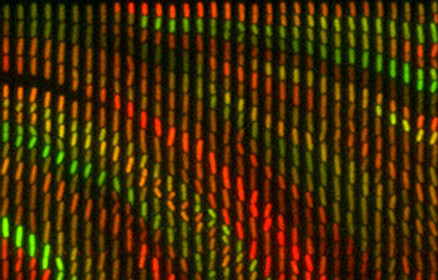What types of gene regulatory dynamics do cells use?
Our projects in bacteria and plants aim to characterise the dynamics of gene expression at the single-cell and single-plant levels and to understand the mechanisms underlying these dynamics. We are interested in characterising the level of variability in gene expression dynamics between cells and individuals and are exploring hypotheses for how the extent of variability is regulated for different genes.
Projects include:
Activation dynamics of bacterial alternative sigma factor circuits. Using time-lapse microscopy we have found bacterial cells can pulse on and off activation of alternative sigma factors. We have observed a range of dynamic behaviours that can be explained by simple mathematical models. See Park et al., 2018, Patange et al., 2018, Young et al., 2013, Locke et al., 2011).
Molecular time-sharing through dynamic pulsing in single cells. In collaboration with the Elowitz and Garcia-Olalvo labs, using time-lapse microscopy we found that multiple alternative sigma factors activated in ~1 hour pulses in a stochastic and repetitive fashion. Analysis of sigma factor pairs revealed that two sigma factors rarely pulse simultaneously, and some pairs are anticorrelated. These results indicate that alternative sigma factor species can effectively ‘time-share,’ or take turns utilizing, RNAP. Time-sharing provides a mechanism for cells to dynamically control the distribution of cell states within a population. Since core molecular components are limiting in many other biological systems, time-sharing may represent a common mode of regulation. See Park et al., 2018.

Variable gene expression in Arabidopsis. We used RNA‐seq on individual seedlings to detect inter‐individual gene expression variability in Arabidopsis thaliana. We found 9% of the transcriptome is highly variable for at least one time point during the day/night cycle. Highly variable genes tend to be involved in the response to the environment. They also tend to be shorter, to be targeted by a higher number of transcription factors and to be characterised by a “closed” chromatin environment. See Cortijo et al., 2018
Gene expression variability for individual genes of interest can be viewed on https://jlgroup.shinyapps.io/AraNoisy/.
